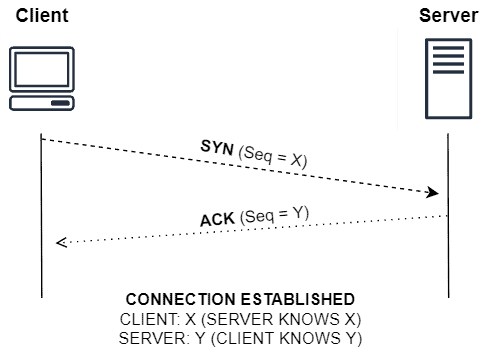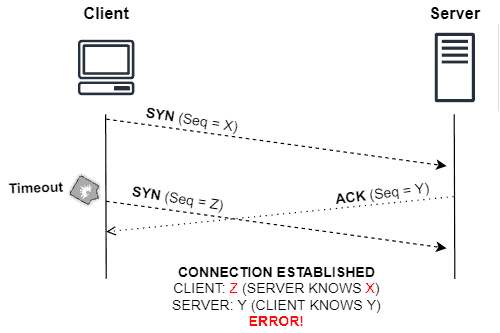1. 引言
握手(Handshake)是一种常见的建立连接的行为。在现实生活中,它可能是两个商务人士开始交谈前的礼节性动作。在计算机网络中,设备或进程通过执行握手协议来建立连接,从而按照事先协商好的参数和规则进行通信。
本文将深入探讨两种常见的握手协议:两次握手(Two-Way Handshake) 与 三次握手(Three-Way Handshake)。我们的目标是理解它们的工作机制、优缺点,以及为何三次握手成为主流标准。
2. 握手基础概念
握手本质上是通信双方在正式传输数据前进行的协商过程。它可以协商通信协议、数据编码方式、最大传输速率等参数。
以下是一些需要握手的常见场景:
- ✅ TCP(传输控制协议):建立 TCP 连接时采用三次握手,确保通信双方同步序列号并建立可靠的连接。
- ✅ TLS(安全传输层协议):客户端与服务端通过握手协商加密算法、交换密钥等安全参数。
- ✅ SMTP(简单邮件传输协议):在建立 TCP 连接后,SMTP 客户端与服务器通过握手进行身份验证并协商通信参数,如加密方式和最大邮件大小。
- ✅ 拨号上网:调制解调器通过握手协商通信协议、调制方式等,以优化连接质量。
3. 两次握手(Two-Way Handshake)
两次握手是一种较为简单的连接建立方式,通常涉及 SYN(同步) 和 ACK(确认) 消息交互。
握手流程如下:
- 客户端发送 SYN 消息,携带一个初始序列号 X。
- 服务端收到后,发送 ACK 消息,携带自己的序列号 Y,并确认客户端的 X。
这样,连接就建立完成了。
流程图如下:

⚠️ 问题所在:
如果服务端的 ACK 消息在网络中延迟,客户端可能会超时并重新发送 SYN 消息。此时服务端可能已经处理过第一个 SYN,并发送了 ACK,但由于延迟,它会收到新的 SYN 消息。
此时,客户端使用新的序列号 Z 发送数据,但服务端却期望接收基于 X 的数据,导致序列号不一致,进而引发数据错乱。
流程示意如下:

因此,两次握手存在连接同步失败的风险。
4. 三次握手(Three-Way Handshake)
三次握手在两次握手的基础上增加了一次确认步骤,确保双方都确认了彼此的序列号,从而避免了同步失败的问题。
具体流程如下:
- 客户端发送 SYN 消息,携带序列号 X。
- 服务端响应 SYN-ACK,携带自己的序列号 Y,并确认客户端的 X。
- 客户端发送 ACK 消息,确认服务端的 Y。
三次握手完成后,连接正式建立。
流程图如下:

✅ 优势:
- 双方都能确认对方的发送与接收能力
- 避免了由于 ACK 延迟导致的序列号错乱
- 提高了连接的可靠性
❌ 缺点:
- 增加了一次通信开销,连接建立时间稍长
- 在高并发场景下可能略微增加服务器负担
⚠️ 踩坑提醒:
某些新手开发者可能误以为两次握手就足够,但在实际网络环境中,丢包、延迟、重传是常态,两次握手很容易导致连接建立失败或数据混乱。
5. 总结
握手协议是网络通信中不可或缺的一环。两次握手虽然简单,但由于其潜在的同步问题,在实际应用中已被淘汰。三次握手通过增加一次确认机制,显著提升了连接的可靠性,因此被广泛应用于 TCP、TLS 等协议中。
✅ 关键点回顾:
| 项目 | 两次握手 | 三次握手 |
|---|---|---|
| 消息次数 | 2 | 3 |
| 是否可靠 | ❌ | ✅ |
| 是否存在序列号冲突风险 | ✅ | ❌ |
| 实际应用 | 否 | ✅ |
总之,握手不仅是一种连接建立机制,更是保障通信可靠性的基石。理解其原理,有助于我们在网络编程中更好地设计和排查问题。